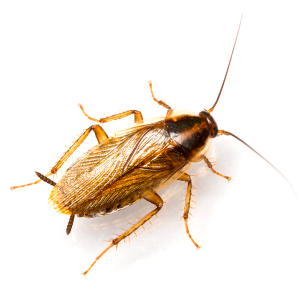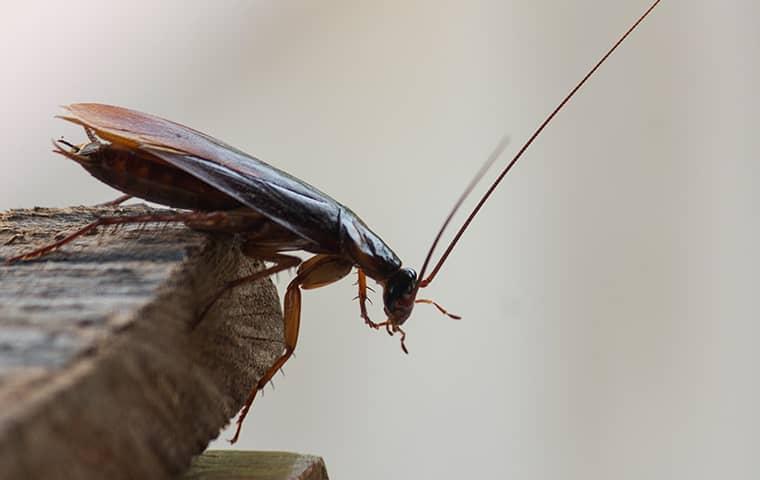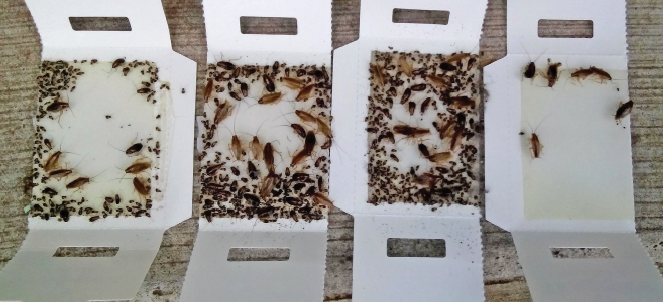Roach Control
When dealing with cockroaches, it’s best to hire a professional – they can be very good at hiding and even better at hiding their eggs. They reproduce very quickly and in a short time. As the largest of the home infesting pests, they are easier to spot, yet leave no trace of their existence in your home. If a cockroach infestation is not addressed within a timely manner, it could get out of hand and cause significant damage. The inside of your home is a great place for them to thrive with unlimited food, water, warmth and places to hide. Roaches can be a pest all year long! They can be brought in by hiding in deliveries, grocery bags, used appliances and electronics and personal items like purses or backpacks. Some roaches can even carry and transfer disease as well as a variety of pathogenic organisms such as food poisoning, diarrhea and other illnesses
Types of roaches:
American Roaches
Brown Banded Roaches
German Roaches
Oriental Roaches
Pennsylvania Wood Roaches
German Cockroach Biology Basics
Have been on earth for over 300 million years.
Commonly found indoors in restaurants, bars, grocery stores, homes, apartments, etc.
Adults are 1/2-5/8 inches long, tan to light brown, and have 2 dark parallel lines from the back of the head to the wings.
Have developed wings but do not fly.
Have 3 development stages: egg, nymph, and adult.
Female carries purse shaped egg capsule containing up to 48 eggs and can produce 4 to 8 capsules in her lifetime – 1 every 6 weeks.
Can become an adult within 8 weeks and have a life span of 20-30 weeks.
1 female can be responsible for over 10,000 offspring in one year.
Mostly active at night but send over 75% of their life in a crack or crevice harborage.
Prefers to live in an environment close to food, water, shelter, and warmth.
Over 75% of an infestation consists of pre-adults.
Can trans-locate from neighboring and adjoining buildings.
German Cockroaches Transmit Disease
German cockroaches transfer disease and a variety of pathogenic organisms such as: parasitic protozoans, food poisoning, dysentery, diarrhea, and other illnesses.
German cockroach excrement and cast skins dramatically contribute to allergies and asthma.
German Cockroaches Are Brought In By:
Food, beverage, and all other commercial deliveries
Paper packaging and cardboard boxes
Grocery bags
Used appliances and electronics
Personal items such as: clothing, backpacks, purses, radios, etc.

How Cockroaches Get Into Homes
seeing a cockroach every now and then is not unheard of. It is unpleasant, though, and it’s something that you hope occurs when you aren’t in your own home.
The Dangers of Cockroaches
Cockroaches aren’t just unsightly bugs. They can actually cause a number of problems for homeowners, and they are definitely unwelcome in your home.
Cockroaches are unsanitary. They spend a lot of time in areas such as garbage cans and sewers, picking up the bacteria, germs, and parasites that are rampant in those areas. When they gain entry to your home, they bring all that filth with them into your living areas. These germs are then scattered wherever cockroaches roam. Your countertops, food prep areas, and your food itself are all vulnerable to contamination, leaving you susceptible to a host of illnesses, such as Salmonella, dysentery, and parasites such as tapeworm.
How Cockroaches Get Into Your Home
Although they seem enormous when you have a surprise encounter with one, cockroaches are not that large. Their rather flat bodies have the ability to squeeze through fairly tight spaces. They can get into your house through spaces under doors, cracks in your foundation, and tears in your screens. Even small openings may be large enough to permit cockroaches to enter your home. Perform an inspection around the outside of your home and seal off any areas you find where they may be gaining access.
Why Cockroaches Get Into Your Home
Several things will attract cockroaches to your home. If any of these sound familiar, take the necessary steps to eliminate them and you’ll reduce the chance of cockroaches entering your home.
Roaches are attracted to water and moisture. If they’ve found their way into your home, you’ll often see them in moist areas, such as the bathroom, under the kitchen sink, or in your basement. If there are leaky pipes in your home, or other water-damaged areas, repair them immediately. If humidity is high in your home, improve ventilation and use dehumidifiers to get rid of excess moisture.
Excess moisture outside your house will also attract cockroaches. If your yard tends to be wet or there are other areas of moisture, work to reduce them.
If you leave garbage out, cockroaches will be attracted to it. Outside, cover trash bins with tightly-fitting lids. Inside, remove garbage frequently from your home.

New Research Reinforces Cockroach-Sanitation
To keep these pests from invading, follow the common-sense rules of cleanliness. To kill them, use traps and bait. Don’t bother using foggers, sprays and aerosols, which are less effective and can contaminate food, floors and counters.
These insights were confirmed by a seven-month collaboration between Rutgers University-New Brunswick and the New Brunswick Housing and Redevelopment Authority and led by Changlu Wang, professor of entomology at the School of Environmental and Biological Sciences. The resulting study is published in the Journal of Economic Entomology.
Wang and his team did their survey in a public housing project with 258 apartments in 40 buildings. Their first step was to find out which pests, and how many of each pest, lived in those buildings. Cockroaches were present in 28 percent of the apartments; rodents in 11 percent; bed bugs in 8 percent. Surprisingly, this kind of pest data for an entire community is hard to come by, Wang said
“The usual way to figure out how many of what pests are in a community is to count complaints,” Wang said. “And complaints are just not very reliable, because not everybody complains.”
Wang and his team visited all accessible apartments in the community and set traps in strategic spots in each apartment, which not only helped them identify pests but identify where they were coming from. They then treated those apartments using baits and traps and reduced the number of cockroach infestations by 85 percent over seven months

Roach Control
Roaches
Roaches are one of the nastiest pests to deal with; they reproduce quickly, carry diseases, and are very resilient. They are rarely seen during the day and often go unnoticed until it’s too late. At Green & Safe Pest Control, we have all the necessary means to eliminate roaches in their entirety. Taking care of the problem quickly is the best approach. We provide roach control in Fort Worth and surrounding cities.
American Cockroaches are one of the largest types of roaches. They are brown and can fly. Roaches can carry diseases and transmit them to humans by walking on food preparation surfaces. If you see one in your home, give us a call as soon as possible!
German cockroaches are mid-sized and are found in the US. They are a tan color with two black stripes down the back. German cockroaches can reproduce very quickly. A single egg can contain 20-30 larvae. They secrete a “musty” odor. Often that’s how you will detect that you have a problem. Like all roaches, they spread bacteria and need to be eliminated.
Oriental Roaches, also known as “Water Bugs,” often use plumbing to access your home. They are dark brown and sluggish compared to other roaches. While they are native to Asia, hence their name, they have become a widespread issue in North America.
Roaches are one of the most difficult pests to eradicate, especially after they have already established a colony. Cockroaches reproduce at a rapid rate, so they can become a major issue very quickly. When it comes to roaches, it is better to be proactive instead of reactive. We suggest getting started on one of our general pest control programs before you see any signs of roaches. Prevention is your best line of defense against these disgusting creatures. That being said, if you already see signs, it’s definitely time to give us a call. The problem might be bigger than you realize!

TIPS FOR COCKROACH PREVENTION
There are over 4,500 species of cockroaches worldwide, but only around 70 species are found in the United States. Most of these live in wooded habitats and are rarely seen. Phew! But a few species are considered major pests, and the best way to tell them apart is their size. German cockroaches are small and light brown with two black stripes on their backs. Larger cockroach species are dark brown with developed wings and are often called “palmetto bugs,” especially in South Carolina
Pain & Prevention
Aside from being downright icky, cockroaches are a health and safety issue. They are known to spread bacteria and trigger allergies and asthma. They will also contaminate any food, utensils, and surfaces they crawl on. Infestations can start when cockroaches come inside the home. Sometimes this is hard to avoid, but there are plenty of things you can do to prevent both small and large cockroaches from sticking around.
Keep both the inside and outside of your home clean, dry, and uncluttered.
Wipe up spilled food and water.
Don’t leave food sitting out, and don’t let trash accumulate inside.
Regularly clean appliances and countertops.
Vacuum carpets, rugs, and upholstered furniture on a regular basis to remove crumbs and other food debris.
Eliminate moisture issues outside, like standing water, clogged gutters, or excessive amounts of mulch, pine straw, or leaf litter.
Keep bushes and tree limbs trimmed back from the house.
Store firewood away from the home, and eliminate as much clutter and debris as possible from around the foundation.
Turn off unnecessary lights at night, and don’t leave uneaten pet food out overnight.
Make sure screens on windows, doors, and vents are in good condition and seal up holes surrounding pipes in the foundation wall.
Habits & Habitat
German cockroaches have adapted to living with humans for so long that they are now only found indoors near water sources. They like to live in warm, dark areas near moisture, including cracks, crevices, and voids around kitchen and bathroom cabinets, as well as around or inside appliances like refrigerators, stoves, toaster ovens, and microwaves. Large cockroaches, or palmetto bugs, prefer similar environments but mostly live outdoors. However, they will wander inside homes in search of food and shelter, and when conditions are right, they can live and breed indoors. Cockroaches will eat just about anything humans eat, and they need water on a daily basis.
